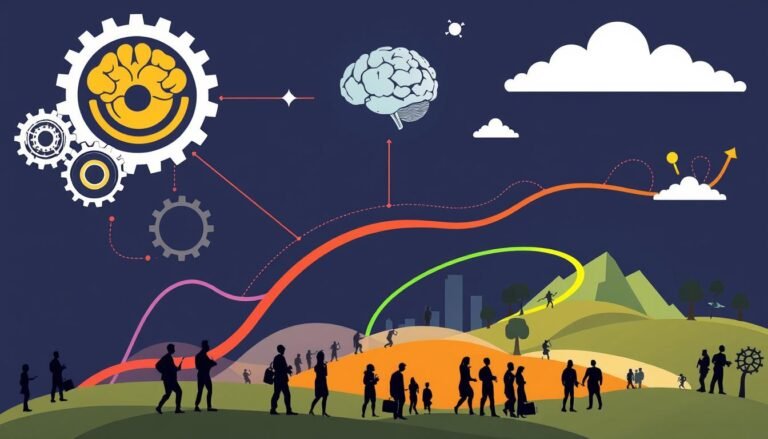The Secret to a Positive Organizational Climate: Psychological Strategies
Ever wondered why some workplaces are full of energy while others feel dull? The answer is the organizational climate. It shapes how employees feel and work, affecting everything from productivity to happiness. Yet, many leaders ignore its power.
Organizational climate is what employees feel about their work place. It’s shaped by company rules, leadership, and daily talks. It’s different from culture, which is deeper, focusing on values. Climate is about the immediate feel of the workplace.
A good climate can make a job exciting. It makes employees happy, keeps them from leaving, and even makes customers happier. Companies like Google and Southwest Airlines are known for their great climates, helping them succeed.
To create a positive work place, you need to understand the mind. Things like biases and emotional smarts matter. By using these insights, leaders can make strategies that really connect with their teams.
Key Takeaways
- Organizational climate greatly affects how employees act and work
- A positive climate means happier employees and less leaving
- Companies like Google and Southwest Airlines stand out because of their great climates
- Knowing about the mind is key to a better work place
- Leadership and how they talk to people are crucial for a good climate
Understanding Organizational Climate: Definition and Importance
Organizational climate is key in shaping a company’s culture and how employees feel. It’s the shared view of the work environment that affects how people feel and do their jobs.
What is organizational climate?
Organizational climate is what employees think about their work environment. It’s a concept that shows what makes a workplace unique. It includes things like how people get along, the main focus, and how much freedom employees have.
Differences between organizational climate and culture
Organizational climate and culture are not the same, even though they’re often mixed up. Climate is about the current feel and what employees think now. Culture is about the deeper, lasting values and beliefs. Climate can change quickly, influenced by leaders and policies.
| Organizational Climate | Organizational Culture |
|---|---|
| Short-term perceptions | Long-term values and beliefs |
| More easily changed | Deeply ingrained and resistant to change |
| Focuses on current atmosphere | Represents historical context |
Impact on employee behavior and performance
A good organizational climate can really help employees do their best. It makes them happier, work better together, and serve customers better. Companies with great climates have happier employees who stay longer because they feel important and supported.
“The right organizational climate can transform average workers into high performers by creating an environment where people feel motivated and supported.”
It’s important to understand and improve a positive organizational climate. This helps create a great work place where everyone can do their best.
Key Dimensions of Organizational Climate
Organizational climate greatly affects how teams work together and perform. It includes several key areas that shape how employees see their work place. Knowing these areas is key to bettering how teams work and improving the work environment.
Research points to four main types of organizational climates:
- People-oriented
- Rule-oriented
- Innovation-oriented
- Goal-oriented
Each type impacts how employees act and feel in different ways. For example, innovation-oriented climates boost creativity and taking risks. On the other hand, rule-oriented ones stress following set rules.
The Organizational Social Context (OSC) measure looks at three main parts of organizational culture:
- Proficiency: Putting clients first
- Rigidity: Following strict rules
- Resistance: Fighting change
Studies find that high proficiency and low resistance and rigidity result in better client results and lasting programs. This shows the value of a flexible and client-centered climate.
The OSC also checks three main parts of organizational climate:
| Dimension | Description | Impact |
|---|---|---|
| Engagement | Meaningful work accomplishments | Lower turnover rates |
| Functionality | Support and clear roles | Better service quality |
| Stress | Work-related stress levels | Higher turnover if elevated |
Organizations with high engagement and functionality and low stress do better. By focusing on these areas, leaders can build a positive climate. This improves how teams work and perform.
The Psychology Behind a Positive Work Environment
Understanding workplace psychology is key to fostering a positive work environment. Employee motivation and leadership skills play crucial roles in shaping organizational climate. Let’s explore the psychological factors that contribute to a thriving workplace.
Cognitive Factors Influencing Workplace Perceptions
How employees perceive their work environment greatly impacts their performance and satisfaction. Studies show that positive workplace cultures lead to higher employee engagement and retention rates. Companies with positive cultures experience higher average annual returns, highlighting the importance of cognitive factors in shaping workplace perceptions.
Emotional Intelligence in Leadership
Leaders with high emotional intelligence are better equipped to create a positive work environment. They foster psychological safety, allowing employees to voice opinions without fear. This approach is crucial for building a healthy workplace culture and improving employee satisfaction.
Motivational Theories and Their Application
Applying motivational theories can significantly boost employee engagement. Providing autonomy, mastery, and purpose in the workplace improves satisfaction and productivity. Strong work relationships are powerful for well-being, even more so than meaningful work alone.
| Positive Psychology Factor | Impact on Workplace |
|---|---|
| Positive Emotions | Reduce stress, enhance resilience, improve teamwork |
| Strengths Utilization | Higher happiness levels, lower depression rates |
| Strong Relationships | Boost physical and mental health, improve collaboration |
| Sense of Accomplishment | Increase self-esteem, confidence, and motivation |
By implementing these psychological strategies, organizations can create a positive work environment that fosters growth, satisfaction, and productivity among employees.
Assessing Your Current Organizational Climate
Checking your workplace is key for success. Tools like employee surveys and organizational analysis give insights. They show how employees feel and what needs work.
These assessments often use over 50 questions. They look at many parts of the work environment. It takes about a month to a month and a half to do this.
It’s important for employees to answer honestly. This is why surveys are kept anonymous. New tech makes it easier and cheaper for companies to do these checks.
“Evaluating the organizational climate is a fundamental component of various business management methodologies like the Balanced Scorecard and EFQM.”
Understanding the results is crucial. Special software can help with this. Experts also suggest looking at open-ended questions for a deeper view.
| Signs Indicating Need for Assessment | Benefits of Assessment |
|---|---|
| Workplace conflict | Identifies areas of strength |
| Low employee engagement | Highlights areas for improvement |
| Declining productivity | Provides leadership feedback |
| High turnover rate | Helps develop action plans |
| Lack of communication | Strengthens existing approaches |
It’s important for managers to understand and act on the findings. A specialist can help compare results and plan for betterment. Regular checks and updates are vital for a good work environment.
Leadership Strategies for Cultivating a Positive Climate
Effective leadership is key to a positive work environment. It involves building trust, encouraging open communication, and empowering employees. Let’s look at strategies leaders can use to make their workplace thrive.
Developing Trust and Transparency
Trust is essential in a positive workplace. Research shows 70% of employees value trust from their leaders for job happiness. Companies that are open see a 30% jump in employee happiness. Leaders can build trust by:
- Sharing information openly and consistently
- Admitting mistakes and taking responsibility
- Following through on commitments
Encouraging Open Communication
Good communication leads to teamwork and new ideas. Leaders should let employees share their thoughts and worries freely. This can increase employee commitment by 58%. Ways to do this include:
- Having regular team meetings and one-on-ones
- Using digital tools for feedback
- Listening well and showing empathy
Promoting Employee Autonomy and Empowerment
Empowering employees boosts engagement and productivity. Companies that involve employees more are 2.5 times more likely to succeed. Leaders can empower by:
- Giving meaningful tasks and decision power
- Supporting skill growth with resources
- Valuing and rewarding new ideas
| Leadership Strategy | Impact on Organizational Climate |
|---|---|
| Transparent Communication | 30% increase in employee satisfaction |
| Transformational Leadership | 58% increase in employee commitment |
| Employee Empowerment | 2.5x higher likelihood of business success |
By using these strategies, companies can foster a positive climate. This leads to better engagement, innovation, and success. Remember, improving leadership is a continuous effort that needs dedication and ongoing improvement.
Creating a Climate of Innovation and Creativity
In today’s fast-paced business world, innovation is crucial for growth. A Boston Consulting Group survey shows that senior executives see innovation as their top goal. To encourage creative thinking, companies need to create an environment that welcomes new ideas and risk-taking.
Great companies offer resources for trying new things and reward creative ideas. They make spaces for teamwork and offer flexible work options. Projects that involve different departments bring fresh views and help solve problems in new ways.
Leaders are key in creating this innovative climate. They should show innovative behavior and make sure employees feel safe to share and try out new ideas. Research by West (1990) shows that feeling part of a team and being sure of themselves boosts idea-making.
“Creativity is thinking up new things. Innovation is doing new things.” – Theodore Levitt
The World Economic Forum highlights the role of creativity in moving organizations forward. By building a culture of innovation, companies can unlock their employees’ full potential and achieve lasting growth.
| Climate Type | Characteristics | Impact on Innovation |
|---|---|---|
| Open Climate | Encourages free expression | High potential for creativity |
| Autonomous Climate | Promotes independence | Fosters individual innovation |
| Controlled Climate | Structured environment | Limited spontaneous creativity |
| Familiar Climate | Informal and relaxed | Encourages collaborative innovation |
Organizational Climate and Employee Well-being
A positive organizational climate is key for employee wellness. Companies that focus on work-life balance and stress management see big improvements. Let’s look at some initiatives that can make the workplace better and happier for everyone.
Work-life Balance Initiatives
Work-life balance programs are a big help for employee wellness. IKEA, for example, saw a 15% boost in employee engagement in 2018. They changed their climate to be more supportive. Flexible hours and remote work are popular because they help employees balance their lives better.
Stress Management Programs
Managing stress at work is crucial for a healthy workplace. Microsoft, for instance, started wellness programs and saw a 20% jump in productivity. These programs include mindfulness, yoga, and mental health resources.
| Company | Initiative | Result |
|---|---|---|
| Microsoft | Wellness Program | 20% increase in productivity |
| Bank of America | Mental Health Support | 20% reduction in employee burnout |
| Marriott International | “Take Care” Campaign | 30% increase in employee engagement |
Fostering a Sense of Belonging and Purpose
Creating a positive climate means making employees feel they belong. TechPulse, for example, saw a 25% rise in satisfaction by letting staff shape their work space. Clear goals and team activities also boost engagement and happiness at work.
By focusing on these areas, companies can make a better work environment. This leads to more productivity, less turnover, and a happier workplace for everyone.
Building Strong Interpersonal Relationships at Work
Workplace relationships are crucial for a positive work atmosphere. Good communication skills can increase productivity and job satisfaction. In fact, workers spend most of their time talking to each other.
Team building activities are key to building strong bonds. They help break down barriers and encourage teamwork. For instance, working on projects with different departments can broaden perspectives and strengthen relationships.
Effective communication is essential for strong relationships. It can boost productivity and customer satisfaction. But poor communication can harm productivity and extend project timelines.
To create a positive work environment, companies should:
- Promote respect and inclusivity
- Train managers in conflict resolution
- Organize regular social events
- Encourage open dialogue among team members
By investing in these areas, companies can make employees feel valued and connected. This improves job satisfaction and overall happiness, as people often spend more time with coworkers than family.
| Benefit | Impact |
|---|---|
| Increased Productivity | 64% improvement |
| Customer Satisfaction | 51% increase |
| Employee Confidence | 49% boost |
| Cost Reduction | 32% decrease in expenses |
By focusing on building strong interpersonal relationships, companies can create a positive work environment. This benefits both employees and the organization.
Recognition and Reward Systems: Psychological Impact
Recognition and reward systems are key in shaping a company’s culture. They boost motivation and productivity when done right. Let’s look at how these systems affect us and how to make them better.
The Power of Positive Reinforcement
Positive feedback can greatly improve how employees feel. A Gallup-Workhuman study showed that those who value recognition feel more connected to their company. This shows how important it is for happiness at work.
Designing Effective Recognition Programs
Companies like Google and Salesforce have unique ways to recognize employees. These methods keep employees engaged and reduce turnover. Most companies use formal recognition to motivate their teams, showing it’s a common practice in HR.
Balancing Intrinsic and Extrinsic Rewards
A good reward system mixes personal growth with bonuses. This meets different needs of employees. Interestingly, recognition can boost performance without costing much money.
“Witnessing recognition can enrich positive experiences in the workplace, enhancing overall wellbeing.”
Recognition doesn’t just help the person being recognized. It also makes others feel better. This shows the wide benefits of well-thought-out recognition programs.
Overcoming Challenges in Changing Organizational Climate
Changing an organization’s climate is tough. Only 30% of companies use the right tools for this, says AssessmentWorks. This shows we need better ways to manage change in the workplace.
People often resist change because of old habits and fear. To fight this, companies need clear goals and ways to measure success. TechSolve Solutions, for example, saw a 20% jump in employee happiness and a 15% rise in productivity with these tools.
Good communication is key in changing an organization. Zappos used surveys to talk to employees and kept a strong culture focused on well-being. This made staff more open to change.
“Effective change management is about bringing people along on the journey, not forcing them to adapt.”
Training and support are essential for a smooth transition. IBM’s survey led to fewer employees leaving and happier workers. With the right help, teams can adjust to new ways of working better.
| Challenge | Solution | Impact |
|---|---|---|
| Resistance to change | Clear communication and employee involvement | Increased buy-in and reduced resistance |
| Lack of expertise | Provide training and support | Improved adaptation to new processes |
| Difficulty in data interpretation | Invest in analysis tools and expertise | Better decision-making based on insights |
Regular checks and updates are crucial for lasting change. Cisco Systems used pulse surveys to get quick feedback. This led to ongoing improvements in their work environment.
Conclusion
Creating a positive work environment is key for success and growth. Research in North Cyprus healthcare shows its importance. It highlights how climate affects employee attitudes and actions.
The study found a link between climate, commitment, and performance. This is important for leaders who want happy and productive teams. By valuing leadership, setting clear goals, and respecting differences, teams can flourish.
Investing in a good work climate brings many benefits. It boosts leader skills, keeps employees, and makes customers happier. A supportive workplace improves well-being and boosts profits, benefiting everyone.
Source Links
- How to create a positive organizational climate
- Organizational Climate: Meaning, Importance, Types & Example
- What is Organizational Climate? 7 Steps to Improve Yours
- Understanding Organizational Climate | SafetyCulture
- What is Organizational Climate? | The Overture Group
- The Role of Organizational Culture and Climate in Innovation and Effectiveness
- Impact of Employees’ Workplace Environment on Employees’ Performance: A Multi-Mediation Model
- Why Workplace Culture Matters – Professional & Executive Development | Harvard DCE
- The science of happiness at work: How positive psychology can increase productivity
- Evaluating and managing the organizational climate
- How do you assess and improve your organization’s culture and climate?
- Do You Need an Organizational Climate Assessment? — The Mediation Group
- Strategies for Leaders to Foster a Positive Organizational Climate
- The Role of Leadership in Shaping Organizational Climate
- Organizational Climate for Innovation and Creativity in the Field of Education: A Theoretical Framework
- Measuring Organizational Climate for Creativity and Innovation
- The Impact of Organizational Climate on Employee Well-being and Productivity: A Comprehensive…
- The Relationship Between Organizational Climate and Employee Wellbeing: Insights from Recent Studies
- Dynamics of organizational climate and job satisfaction in healthcare service practice and research: a protocol for a systematic review
- Optimal Interpersonal Relationships in the Workplace & Social Circles.
- Improving Interpersonal Communication in the Workplace
- Chapter 13: Interpersonal Relationships at Work
- The Impact of Employee Recognition on Company Culture & Performance
- When colleague got recognized: Third-party’s reaction to witnessing employee recognition
- What are the challenges organizations may face when implementing organizational climate analysis tools, and how can they overcome them?
- What are the potential challenges that organizations may face when implementing an organizational climate analysis tool, and how can they be overcome?
- Impact of organizational climate on organizational commitment and perceived organizational performance: empirical evidence from public hospitals – BMC Health Services Research
- Organizational climate: What it is and how to shape it | CQ Net – Management skills for everyone







